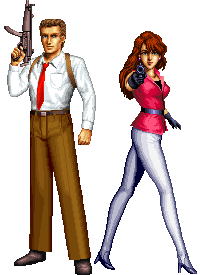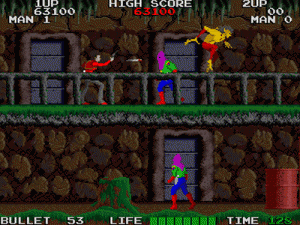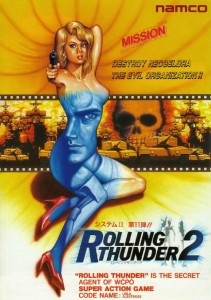It was always a good thing for arcade hits to come home on the Genesis, and Namco gave us many of its best titles. Phelios and Marvel Land immediately come to mind, and I still remember how happy I was to finally see third parties showing the 16-bit love. Sometimes though, Genesis owners were lucky enough to get more than just the singular, popular game and were actually able to see an entire franchise make its home on their favorite black box. Namco did this once before with the Splatterhouse series, and it repeated the offering with Rolling Thunder.
 As a franchise, Rolling Thunder was already a well known name. The first title had been released on a myriad of platforms, and it continues to receive ports to this day, most notably in the Namco Museum Encore for the Japanese Playstation and Namco Museum Battle Collection for the Sony PSP. However, it was the Genesis that received the lion’s share of the games in the series, getting both a port of the first sequel and an exclusive original installment.
As a franchise, Rolling Thunder was already a well known name. The first title had been released on a myriad of platforms, and it continues to receive ports to this day, most notably in the Namco Museum Encore for the Japanese Playstation and Namco Museum Battle Collection for the Sony PSP. However, it was the Genesis that received the lion’s share of the games in the series, getting both a port of the first sequel and an exclusive original installment.
Developer History
Namco, originally called the Nakamura Manufacturing Company, has been making video games seemingly forever, beginning with its first arcade title Gee Bee in 1978. With such bona fide classics as Pac-Man, Galaga, and Dig Dug under its label; it’s been a staple of the industry and has released games consistently for every console since the NES.
While developed by Namco, the first Rolling Thunder was released in U.S. arcades by Atari, back when that company was still the dominant name in coin-ops. Technically, these two were one and the same, as Namco bought a sixty percent share of Atari Games from Warner Communications for $10 million in 1985. Masaya Nakamura, Namco’s owner, had already purchased Atari Japan for $800,000 back in 1972, and he was eager to get a strong distribution foothold for his arcade games in America. With Atari Games, Namco got this along with talented engineers (including the creators of such classics as Marble Madness and Gauntlet), a plant, and a sizeable library of brands. However, Nakamura still viewed the company as an American competitor to Namco and didn’t like sharing ownership with Warner, so he sold twenty percent of his share off to some ex employees and the remaining stock back to Warner.
The Games
Longtime arcade gamers fondly remember what it was like to play the original machine. The James Bond-esque action against hooded henchmen was very cool and a welcome change from the played-out single-screen platformers and beat-’em-ups that populated the arcades of the day. Some today cite it as an obvious inspiration for Namco rival Sega’s own Shinobi, and while no one from either company has ever confirmed this (and it’s doubtful that anyone at Sega ever will), the similarities are pretty obvious. Namco usually made a habit of following Sega’s lead in arcade development during the ’90s, but this is one instance where the former was clearly the one to set the standard. Capcom also paid homage with its NES release of Codename: Viper, a great action romp that could have easily been mistaken for a Rolling Thunder game.
As agent Albatross of the WCPO (World Criminal Police Organization), the player was charged with three simple objectives: rescue agent leila, who had been taken hostage by the evil terrorist organization Geldra and was being held in their underground lair, destroy said organization, and take out its evil leader Maboo once and for all. All Albatross had on his side was a single, paltry pistol and a submachine gun — the latter of which you could only access by entering “Arms” doors during each stage. Each weapon had a limited supply of bullets, and you could enter each Arms door once*, so it was important to use them wisely. Though he could shoot while standing or kneeling, Albatross obviously wasn’t trained in the use of firearms while jumping, which compounded the already notorious difficulty even further. That’s actually something of a question mark in gaming history. Why was Albatross able to leap twenty feet into the air from a standstill to the second floor in each stage, yet unable to jump and fire simultaneously? The world may never know. And with no Bond-like gadgets to aid him, Albatross was facing one hell of an uphill battle.
 A pretty daunting set of circumstances for any secret agent, and while Albatross was up to the task, the real question was whether or not most arcade gamers were super spy material. See, Rolling Thunder was hard. Not “refreshingly challenging,” but downright brutal. Don’t be fooled by the life bar at the bottom of the screen; most everything in this game could kill you with only one or two hits. Even bumping a foe did damage! Needless to say, many a player gave up in frustration long before ever seeing that final boss. Though it only had a total of ten stages (two segments composed of five stages each), the difficulty level guaranteed that no one would blow through it in a single play. However, this didn’t mean that the game was impossible, as its trial-and-error memorization play was indeed something that could be mastered. Like all true arcade classics, patience and a ton of quarters were required.
A pretty daunting set of circumstances for any secret agent, and while Albatross was up to the task, the real question was whether or not most arcade gamers were super spy material. See, Rolling Thunder was hard. Not “refreshingly challenging,” but downright brutal. Don’t be fooled by the life bar at the bottom of the screen; most everything in this game could kill you with only one or two hits. Even bumping a foe did damage! Needless to say, many a player gave up in frustration long before ever seeing that final boss. Though it only had a total of ten stages (two segments composed of five stages each), the difficulty level guaranteed that no one would blow through it in a single play. However, this didn’t mean that the game was impossible, as its trial-and-error memorization play was indeed something that could be mastered. Like all true arcade classics, patience and a ton of quarters were required.
Being that Rolling Thunder had torn up arcades, it was obviously a shoe-in for a home release. Without delay, it was ported to several home computer platforms, but only the NES got a domestic console version (handled as well by Atari, through its home division Tengen). Aside from the more-than-decent NES incarnation, quality varied among the different ports, and most lacked the animated intermissions that featured Leila in various stages of imaginative torture. Though well done and adding a cool sense of urgency to Alabatross’s mission, it’s understandable why they were omitted, as scantily-clad damsels being electrocuted probably wouldn’t have gone over too well with parents, who already had enough reasons to loathe video games. Successful nonetheless, Rolling Thunder fans didn’t have to wait long for a sequel, and Namco had them covered on two different fronts.
Hitting arcades in 1990, Rolling Thunder 2 brought back both agents from the first game (Leila was now playable), along with the original’s gameplay. It also did what a proper sequel should do: improve and expand the original concept. There were now more weapons to use (cluster gun & flamethrower), and Namco introduced an upgradeable life bar. The action was moved outside as well, and stages now took place in different locales all over the world. When it was brought home to the Genesis, Namco went even further, tossing in some new stages and cut scenes!
Geldra was back, and this time they destroyed the world’s communications satellites, plunging the planet into a new dark age. Albatross and Leila once again headed out to stop them, which was easier said than done. Stages now scrolled vertically as well as horizontally, and there were boss battles. The challenge was still there, and even though the individual stages weren’t as unforgiving, Namco included a special surprise for players this time around: you had to go through the game twice to get the true ending! Things got even tougher the second time around, and those unlimited continues were bound to come in handy (so I’m a scrub, big deal!). Still, the improved visuals and level design, coupled with the great two-player gameplay, made this an excellent entry worthy of the name.
I’m not surprised that Rolling Thunder 2 was only released on the Genesis, as Namco’s relationship with Nintendo at this time was rocky, to say the least. It were already beginning to ramp up its support for the console, and this was obviously a perfect fit. It was a bit strange to see the Turbo Grafx-16 get snubbed, however, since Namco was a staunch supporter of that console. A lot of the company’s lesser-known but awesome titles were brought to NEC’s machine, and a big brand like Rolling Thunder could have given it some much-needed exposure in the U.S.
What happened next in the series is still puzzling fans to this day. Namco released another sequel, only this one was a Genesis exclusive. Moreover, it wasn’t released in Japan! This was a odd departure, and it only got odder. Not only was the game’s distribution changed, so was the starring role. Supposedly, our famous spy duo was off chasing after Geldra’s head honcho once more, so newcomer “Jay” was charged with the task of taking out its second-in-command: officer Dread. Animated cut scenes between each of the ten stages told the tale of Jay’s mission to end the Geldra menace once and for all, and the story was a bit more fleshed out this time around.
 Everything else was beefed up again as well. Clocking in at twelve megs, Rolling Thunder 3 offered nine different weapons (which could only be chosen before each level and could not be used again), hidden areas, and even a password feature. Lamentably, two-player support was conspicuously missing. A second character was available via a code, but if you couldn’t bring a friend along, it was nothing more than window dressing. Even so, the game remains extremely playable, and the fact that it’s a Genesis exclusive means that it deserves attention.
Everything else was beefed up again as well. Clocking in at twelve megs, Rolling Thunder 3 offered nine different weapons (which could only be chosen before each level and could not be used again), hidden areas, and even a password feature. Lamentably, two-player support was conspicuously missing. A second character was available via a code, but if you couldn’t bring a friend along, it was nothing more than window dressing. Even so, the game remains extremely playable, and the fact that it’s a Genesis exclusive means that it deserves attention.
For some odd reason, Namco abandoned the franchise after the third game, leaving gamers to ponder if and when the WCPO, Albatross, Leila, and Jay would ever return. Neither of the two sequels have been re-released, which seems strange, given the recent surge in retro compilations. Namco is no stranger to this area, and you’d think that it’d be first in line to offer these classics to a modern audience.
Rolling On?
Though the franchise has sadly fallen off the radar since 1993, it’s still fresh in gamer’s minds. The classic style was something that was easily accessible to arcade goers, and it has stood the passage of time nicely, though some modern gamers might grate their teeth at the challenge level. Namco loves to give its older titles several re-releases without ever adding a new installment, and one can only hope that Rolling Thunder will somehow avoid this fate.
The complete release chronology is as follows:
- Rolling Thunder, Arcade (1986)
- Rolling Thunder, Atari ST (1986)
- Rolling Thunder, MGA LCD Handheld Game (1986)
- Rolling Thunder, Commodore Amiga (1987)
- Rolling Thunder, Commodore 64 (1988)
- Rolling Thunder, Sinclair ZX Spectrum (1988)
- Rolling Thunder, Amstrad CPC (1988)
- Rolling Thunder, Commodore Amiga [Amiga Gold Hits 1] (1988)
- Rolling Thunder, NES (1989)
- Rolling Thunder 2, Arcade (1990)
- Rolling Thunder 2, Genesis (1990)
- Rolling Thunder 3, Genesis (1993)
- Rolling Thunder, Playstation [Namco Museum Encore] (1998)
- Rolling Thunder, Xbox/Playstation 2/GameCube/PC CD-ROM [Namco Museum 50th Anniversary] (2005)
- Rolling Thunder, Sony PSP [Namco Museum Battle Collection] (2005)
Sources
- Rolling Thunder entry. Arcade History. May 26, 2006.
- Rolling Thunder entry. Killer List of Video Games.
- Sheff, David. Game Over: Press Start to Continue. New York: Random House. 1993.
* There was a way around the single reload rule in the arcade version. Once you loaded up, go past the Arms door a distance of two jumps, so that the door is completely off-screen. Then simply go back and revisit the room for more bullets! This is possible because each the game processes each stage via invisible “sections,” and once you cross a section, it forgets everything in it in order to load the next one. Thanks to Arcade History for the neat tip!

Recent Comments